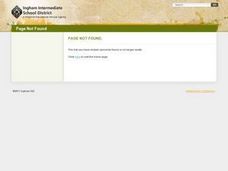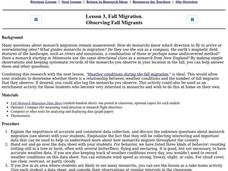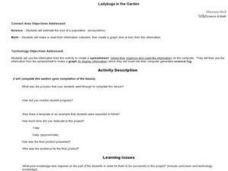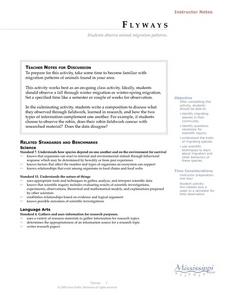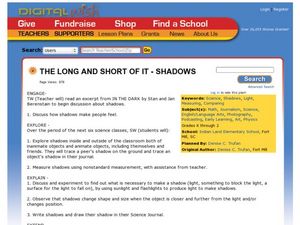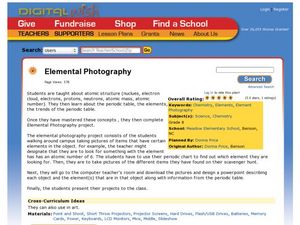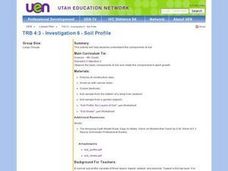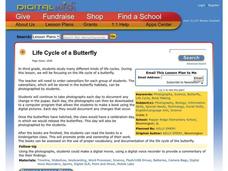ReadWriteThink
Webcams in the Classroom: Animal Inquiry and Observation
Boost observational skills with an inquiry-based lesson that takes scholars on a virtual field trip. With help from webcams, learners observe animals in a zoo or aquarium. Observations go into a journal and a discussion is held to review...
EngageNY
The Most Important Property of Logarithms
Won't the other properties be sad to learn that they're not the most important? The 11th installment of a 35-part module is essentially a continuation of the previous lesson, using logarithm tables to develop properties. Scholars...
Curated OER
Technology Integration Project Weather Unit Plan
Students use a variety of technology-assisted weather observation tools to observe and record local weather. They identify, measure and record weather conditions, summarize types of clouds and make graphs of their observations. Students...
Curated OER
Life in a Log
Young scholars identify insects living in rotting logs. In this decomposition lesson, students observe pieces of a rotting log, they look at the insects that have inhabited the log and create a chart that shows their findings.
Curated OER
Weather Log
Students develop the skill of recording weather observations. Not only students be responsible for recording visual observations of the sky, but also collecting and recording weather instrument data.
Curated OER
Observing and Predicting Weather from a Weather Station
Fourth graders us a Weather Log data chart to record the date, time, day, and weather. They discuss different instruments and charts needed to record the information. Students turn in their weather logs at the end of two weeks and...
Curated OER
Chemical Change in the Kitchen
Students examine chemical changes to food. In this chemical changes lesson plan, students make foods and observe the changes. The changes are recorded in an observation journal. Students photograph food they make at different stages in...
Curated OER
What Lives in the Forest?
Students investigate nearby forests and record their interactions with trees as well as wild life. In this ecology lesson, students read the book, In the Woods: Who's Been Here?, and attend class observational field trips through...
Curated OER
Observing Fall Migrants
Students keep a detailed data collection log of the different types of monarch behavior. They track the weather conditions daily and link it to the migration of the monarchs. They summarize their data using either a graph or a computer...
Curated OER
the Naturalist's Notebook
Third graders, after brainstorming what they already know about trees and what effect the seasons have on them, create a model of a hollow log. They participate in a young naturalist's notebook writing activity while walking outside...
Curated OER
Toting the Log and Lifting the Babe
Students use simple machines that demonstrate force, friction, work and power. They investigate and explain simple machines.
EngageNY
Building Logarithmic Tables
Thank goodness we have calculators to compute logarithms. Pupils use calculators to create logarithmic tables to estimate values and use these tables to discover patterns (properties). The second half of the lesson plan has scholars use...
Curated OER
The Alphabet Garden
Third graders transplant, tend and observe a plant for each letter of the alphabet in a school garden. They work individually to research and select a plant that will grow in their local climate. Students then care for and observe the...
Curated OER
Science and Art Museum
Imagine each one of your learners on task and interested in scientific material. Learners investigate science related art by creating a small museum! Using digital cameras, pupils photograph different scientific actions that look...
Curated OER
Ladybugs in the Garden
Fifth graders estimate the size a population (ecosystems) Students make a chart from information collected then create a graph (line or bar) from this information. Students do a lesson where they observed, examine, and record data...
Curated OER
Central Park Field Trip
Students visit the park to observe signs of spring in the forest and pond environments. In this field trip lesson, students explore the park for various items
Curated OER
Animal Migratory patterns
Young scholars use field research and traditional research to identify migrating species of birds as well as their migratory patterns. Students generate a list of questions regarding migration and a plan to research the questions. A...
Curated OER
The Long and Short of It- Shadows
Students trace shadows. In this light and shadows lesson, students conduct an experiment to determine what a shadow is and what is necessary to make a shadow. Students observe how shadows change as well as write and draw shadows in their...
Curated OER
Elemental Photography
Eighth graders investigate objects for a specific element from the Periodic Table. In this elemental photography lesson, 8th graders observe for and object and photograph it. Students use photographs to prepare a multimedia...
Curated OER
Investigation 6 - Soil Profile
Fourth graders study the components of soil. They observe the basic components of soil and relate the components to plant growth. They record color, texture, and kinds of materials on their profile log (light color, denser, grittier -...
Curated OER
Life Cycle of A Butterfly
Third graders study the life cycle of the butterfly. In this life cycle instructional activity, 3rd graders observe caterpillars in their classrooms. Students put the caterpillars in butterfly habitats and photograph them at each stage...
Curated OER
Lesson 4: Author's Purpose
Learners identify the author's purpose in various poems from the book Words with Wings: A Treasury of African-American Poetry and Art. In order to determine the purpose, pupils first observe as the teacher completes a PIES char...
Curated OER
Surface Meteorological Observation System (SMOS)
Students monitor local surface weather conditions for at least 30 days. They interpret the data by graphing it and detemining percentages.
Curated OER
Flowers, Pods, and Seeds
Students gain an understanding of living organisms. the complete a plant growth data log to chart plant growth and to make observations, predictions, and personal reflections.





